ESP KIA Sorento 2009 2.G Owner's Guide
[x] Cancel search | Manufacturer: KIA, Model Year: 2009, Model line: Sorento, Model: KIA Sorento 2009 2.GPages: 327, PDF Size: 5.03 MB
Page 161 of 327
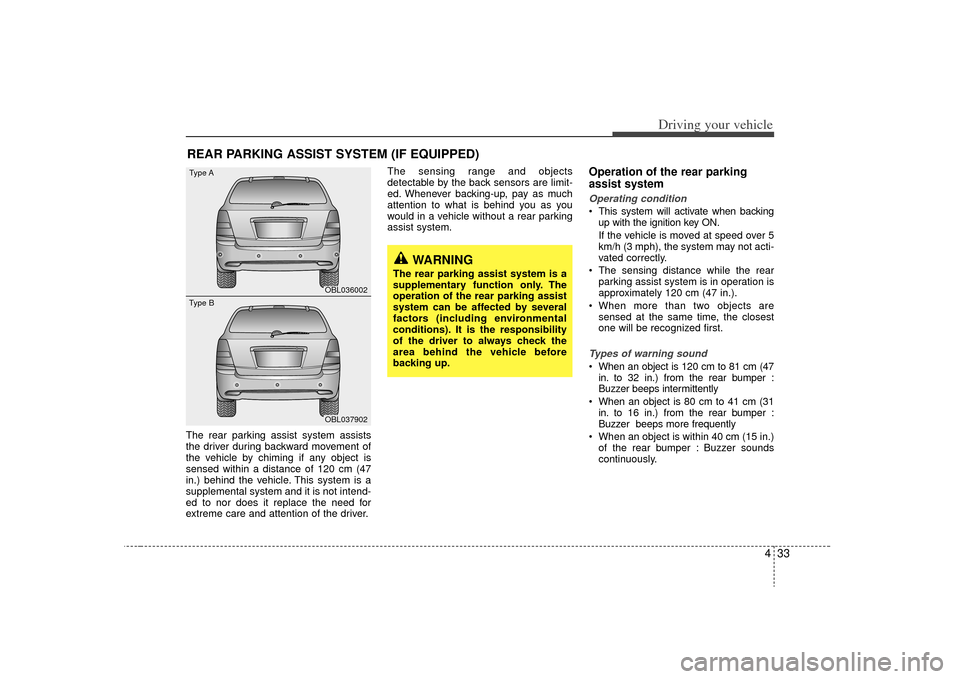
433
Driving your vehicle
The rear parking assist system assists
the driver during backward movement of
the vehicle by chiming if any object is
sensed within a distance of 120 cm (47
in.) behind the vehicle. This system is a
supplemental system and it is not intend-
ed to nor does it replace the need for
extreme care and attention of the driver.The sensing range and objects
detectable by the back sensors are limit-
ed. Whenever backing-up, pay as much
attention to what is behind you as you
would in a vehicle without a rear parking
assist system.
Operation of the rear parking
assist systemOperating condition This system will activate when backing
up with the ignition key ON.
If the vehicle is moved at speed over 5
km/h (3 mph), the system may not acti-
vated correctly.
The sensing distance while the rear parking assist system is in operation is
approximately 120 cm (47 in.).
When more than two objects are sensed at the same time, the closest
one will be recognized first.Types of warning sound When an object is 120 cm to 81 cm (47in. to 32 in.) from the rear bumper :
Buzzer beeps intermittently
When an object is 80 cm to 41 cm (31 in. to 16 in.) from the rear bumper :
Buzzer beeps more frequently
When an object is within 40 cm (15 in.) of the rear bumper : Buzzer sounds
continuously.
REAR PARKING ASSIST SYSTEM (IF EQUIPPED)
WARNING
The rear parking assist system is a
supplementary function only. The
operation of the rear parking assist
system can be affected by several
factors (including environmental
conditions). It is the responsibility
of the driver to always check the
area behind the vehicle before
backing up.
OBL036002OBL037902
Type A
Type B
Page 163 of 327
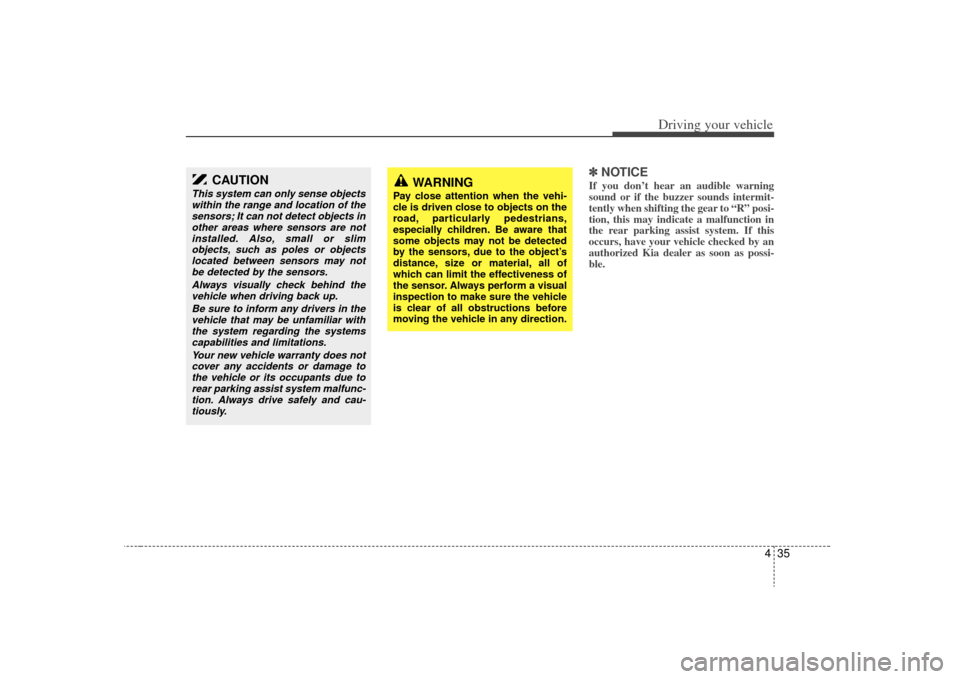
435
Driving your vehicle
✽
✽NOTICEIf you don’t hear an audible warning
sound or if the buzzer sounds intermit-
tently when shifting the gear to “R” posi-
tion, this may indicate a malfunction in
the rear parking assist system. If this
occurs, have your vehicle checked by an
authorized Kia dealer as soon as possi-
ble.
WARNING
Pay close attention when the vehi-
cle is driven close to objects on the
road, particularly pedestrians,
especially children. Be aware that
some objects may not be detected
by the sensors, due to the object’s
distance, size or material, all of
which can limit the effectiveness of
the sensor. Always perform a visual
inspection to make sure the vehicle
is clear of all obstructions before
moving the vehicle in any direction.
CAUTION
This system can only sense objects
within the range and location of thesensors; It can not detect objects inother areas where sensors are not installed. Also, small or slimobjects, such as poles or objectslocated between sensors may not be detected by the sensors.
Always visually check behind thevehicle when driving back up.
Be sure to inform any drivers in thevehicle that may be unfamiliar withthe system regarding the systems capabilities and limitations.
Your new vehicle warranty does notcover any accidents or damage tothe vehicle or its occupants due torear parking assist system malfunc- tion. Always drive safely and cau-tiously.
Page 181 of 327
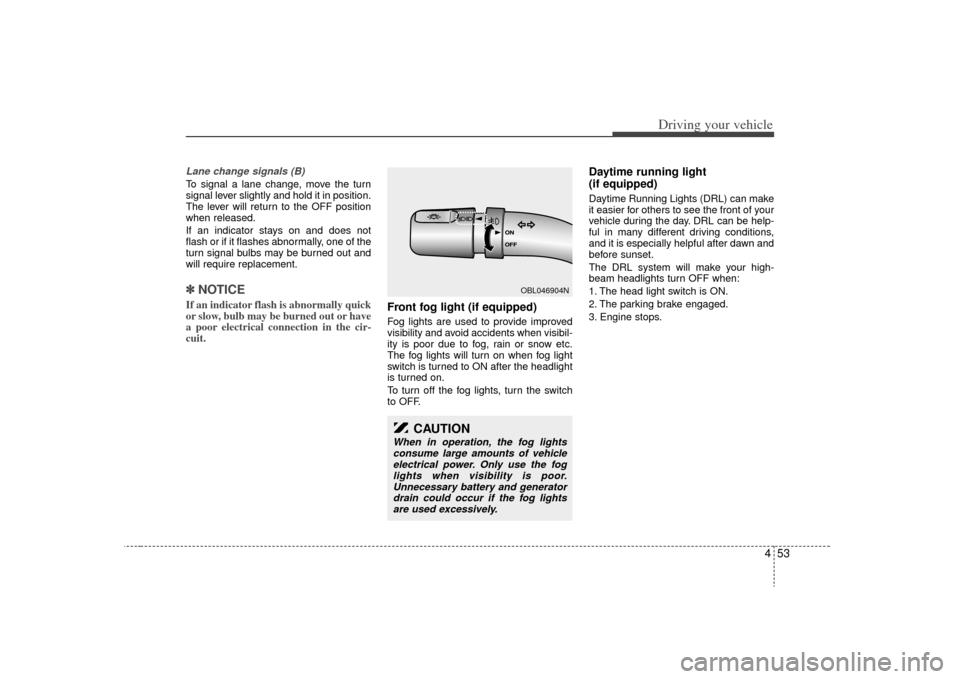
453
Driving your vehicle
Lane change signals (B)To signal a lane change, move the turn
signal lever slightly and hold it in position.
The lever will return to the OFF position
when released.
If an indicator stays on and does not
flash or if it flashes abnormally, one of the
turn signal bulbs may be burned out and
will require replacement.✽ ✽
NOTICEIf an indicator flash is abnormally quick
or slow, bulb may be burned out or have
a poor electrical connection in the cir-
cuit.
Front fog light (if equipped) Fog lights are used to provide improved
visibility and avoid accidents when visibil-
ity is poor due to fog, rain or snow etc.
The fog lights will turn on when fog light
switch is turned to ON after the headlight
is turned on.
To turn off the fog lights, turn the switch
to OFF.
Daytime running light
(if equipped)Daytime Running Lights (DRL) can make
it easier for others to see the front of your
vehicle during the day. DRL can be help-
ful in many different driving conditions,
and it is especially helpful after dawn and
before sunset.
The DRL system will make your high-
beam headlights turn OFF when:
1. The head light switch is ON.
2. The parking brake engaged.
3. Engine stops.
OBL046904N
CAUTION
When in operation, the fog lights
consume large amounts of vehicle electrical power. Only use the foglights when visibility is poor.Unnecessary battery and generator drain could occur if the fog lightsare used excessively.
Page 214 of 327
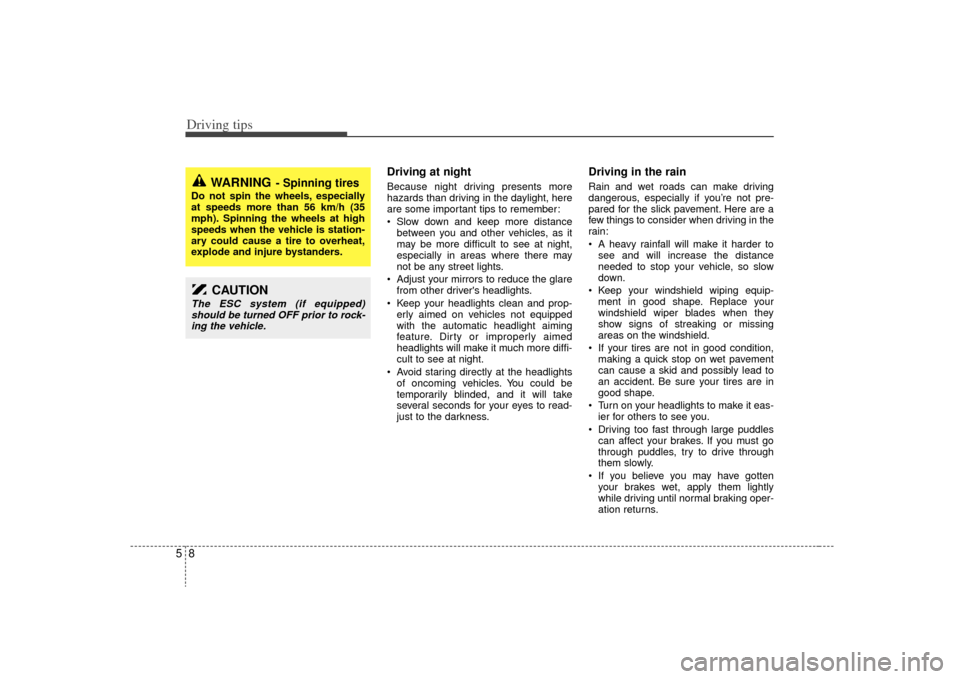
Driving tips85
Driving at night Because night driving presents more
hazards than driving in the daylight, here
are some important tips to remember:
Slow down and keep more distancebetween you and other vehicles, as it
may be more difficult to see at night,
especially in areas where there may
not be any street lights.
Adjust your mirrors to reduce the glare from other driver's headlights.
Keep your headlights clean and prop- erly aimed on vehicles not equipped
with the automatic headlight aiming
feature. Dirty or improperly aimed
headlights will make it much more diffi-
cult to see at night.
Avoid staring directly at the headlights of oncoming vehicles. You could be
temporarily blinded, and it will take
several seconds for your eyes to read-
just to the darkness.
Driving in the rain Rain and wet roads can make driving
dangerous, especially if you’re not pre-
pared for the slick pavement. Here are a
few things to consider when driving in the
rain:
A heavy rainfall will make it harder tosee and will increase the distance
needed to stop your vehicle, so slow
down.
Keep your windshield wiping equip- ment in good shape. Replace your
windshield wiper blades when they
show signs of streaking or missing
areas on the windshield.
If your tires are not in good condition, making a quick stop on wet pavement
can cause a skid and possibly lead to
an accident. Be sure your tires are in
good shape.
Turn on your headlights to make it eas- ier for others to see you.
Driving too fast through large puddles can affect your brakes. If you must go
through puddles, try to drive through
them slowly.
If you believe you may have gotten your brakes wet, apply them lightly
while driving until normal braking oper-
ation returns.
WARNING
- Spinning tires
Do not spin the wheels, especially
at speeds more than 56 km/h (35
mph). Spinning the wheels at high
speeds when the vehicle is station-
ary could cause a tire to overheat,
explode and injure bystanders.
CAUTION
The ESC system (if equipped)should be turned OFF prior to rock- ing the vehicle.
Page 218 of 327
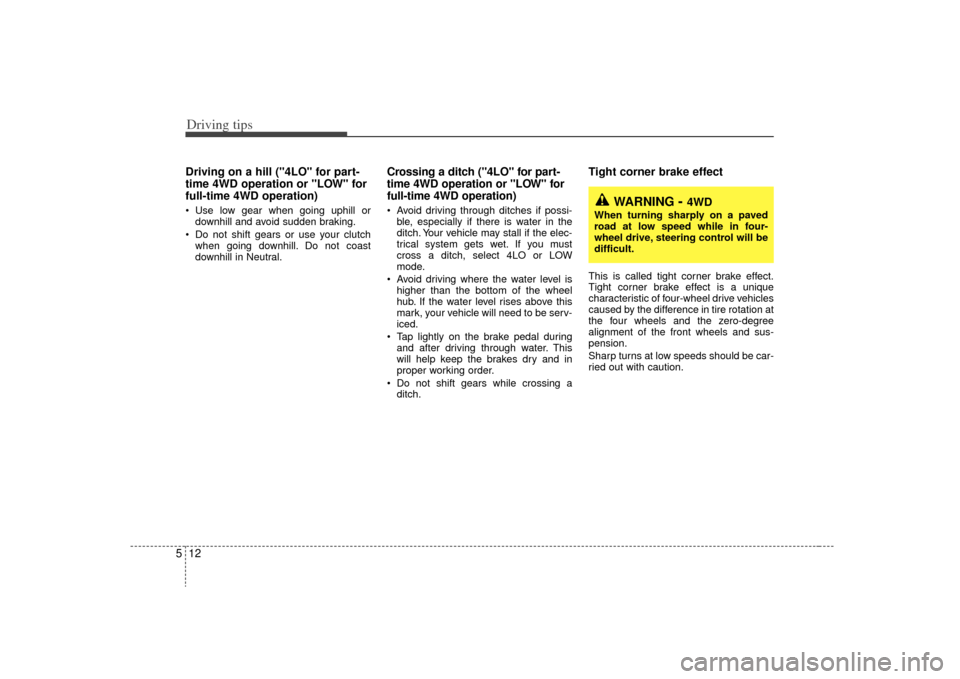
Driving tips12
5Driving on a hill ("4LO" for part-
time 4WD operation or "LOW" for
full-time 4WD operation) Use low gear when going uphill or
downhill and avoid sudden braking.
Do not shift gears or use your clutch when going downhill. Do not coast
downhill in Neutral.
Crossing a ditch ("4LO" for part-
time 4WD operation or "LOW" for
full-time 4WD operation) Avoid driving through ditches if possi-ble, especially if there is water in the
ditch. Your vehicle may stall if the elec-
trical system gets wet. If you must
cross a ditch, select 4LO or LOW
mode.
Avoid driving where the water level is higher than the bottom of the wheel
hub. If the water level rises above this
mark, your vehicle will need to be serv-
iced.
Tap lightly on the brake pedal during and after driving through water. This
will help keep the brakes dry and in
proper working order.
Do not shift gears while crossing a ditch.
Tight corner brake effectThis is called tight corner brake effect.
Tight corner brake effect is a unique
characteristic of four-wheel drive vehicles
caused by the difference in tire rotation at
the four wheels and the zero-degree
alignment of the front wheels and sus-
pension.
Sharp turns at low speeds should be car-
ried out with caution.
WARNING
- 4WD
When turning sharply on a paved
road at low speed while in four-
wheel drive, steering control will be
difficult.
Page 220 of 327
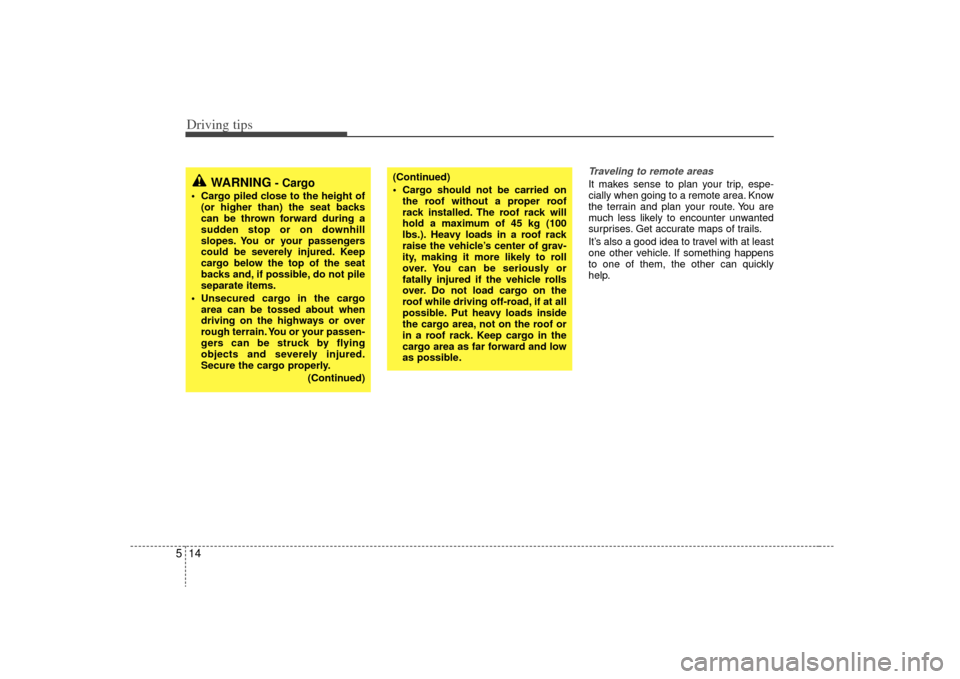
Driving tips14
5
Traveling to remote areasIt makes sense to plan your trip, espe-
cially when going to a remote area. Know
the terrain and plan your route. You are
much less likely to encounter unwanted
surprises. Get accurate maps of trails.
It’s also a good idea to travel with at least
one other vehicle. If something happens
to one of them, the other can quickly
help.
WARNING
- Cargo
Cargo piled close to the height of
(or higher than) the seat backs
can be thrown forward during a
sudden stop or on downhill
slopes. You or your passengers
could be severely injured. Keep
cargo below the top of the seat
backs and, if possible, do not pile
separate items.
Unsecured cargo in the cargo area can be tossed about when
driving on the highways or over
rough terrain. You or your passen-
gers can be struck by flying
objects and severely injured.
Secure the cargo properly.
(Continued)
(Continued)
Cargo should not be carried onthe roof without a proper roof
rack installed. The roof rack will
hold a maximum of 45 kg (100
lbs.). Heavy loads in a roof rack
raise the vehicle’s center of grav-
ity, making it more likely to roll
over. You can be seriously or
fatally injured if the vehicle rolls
over. Do not load cargo on the
roof while driving off-road, if at all
possible. Put heavy loads inside
the cargo area, not on the roof or
in a roof rack. Keep cargo in the
cargo area as far forward and low
as possible.
Page 221 of 327
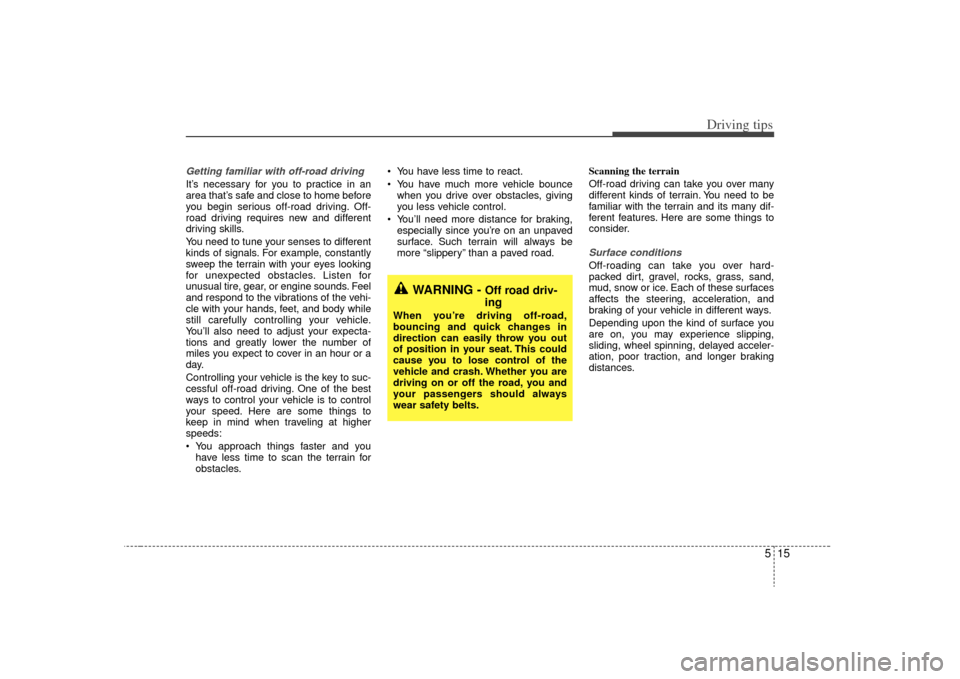
515
Driving tips
Getting familiar with off-road drivingIt’s necessary for you to practice in an
area that’s safe and close to home before
you begin serious off-road driving. Off-
road driving requires new and different
driving skills.
You need to tune your senses to different
kinds of signals. For example, constantly
sweep the terrain with your eyes looking
for unexpected obstacles. Listen for
unusual tire, gear, or engine sounds. Feel
and respond to the vibrations of the vehi-
cle with your hands, feet, and body while
still carefully controlling your vehicle.
You’ll also need to adjust your expecta-
tions and greatly lower the number of
miles you expect to cover in an hour or a
day.
Controlling your vehicle is the key to suc-
cessful off-road driving. One of the best
ways to control your vehicle is to control
your speed. Here are some things to
keep in mind when traveling at higher
speeds:
You approach things faster and youhave less time to scan the terrain for
obstacles. You have less time to react.
You have much more vehicle bounce
when you drive over obstacles, giving
you less vehicle control.
You’ll need more distance for braking, especially since you’re on an unpaved
surface. Such terrain will always be
more “slippery” than a paved road. Scanning the terrain
Off-road driving can take you over many
different kinds of terrain. You need to be
familiar with the terrain and its many dif-
ferent features. Here are some things to
consider.
Surface conditionsOff-roading can take you over hard-
packed dirt, gravel, rocks, grass, sand,
mud, snow or ice. Each of these surfaces
affects the steering, acceleration, and
braking of your vehicle in different ways.
Depending upon the kind of surface you
are on, you may experience slipping,
sliding, wheel spinning, delayed acceler-
ation, poor traction, and longer braking
distances.
WARNING -
Off road driv-
ing
When you’re driving off-road,
bouncing and quick changes in
direction can easily throw you out
of position in your seat. This could
cause you to lose control of the
vehicle and crash. Whether you are
driving on or off the road, you and
your passengers should always
wear safety belts.
Page 222 of 327
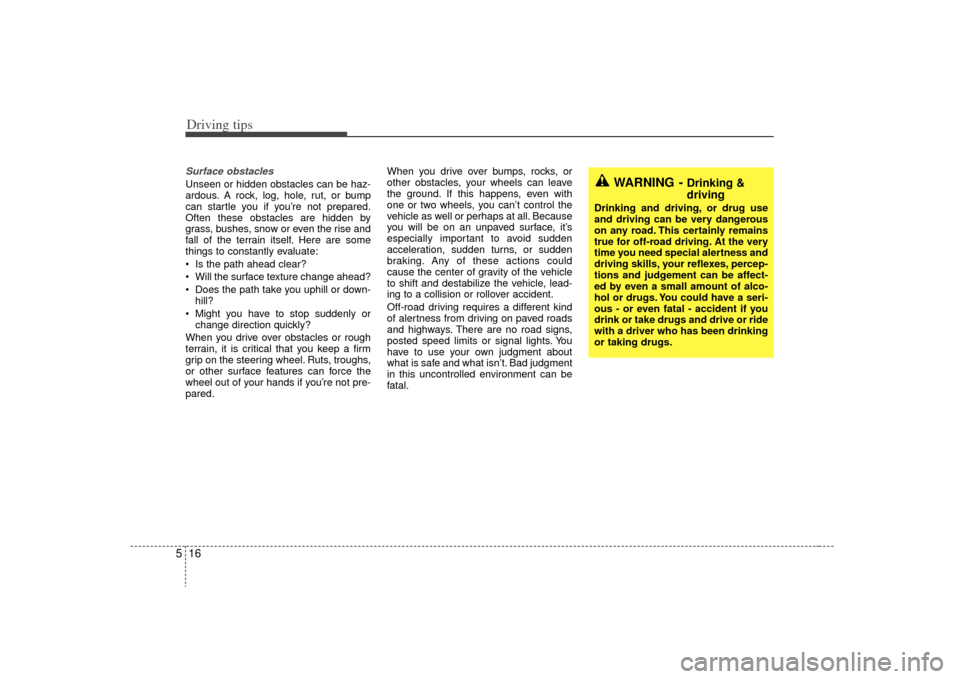
Driving tips16
5
WARNING -
Drinking &
driving
Drinking and driving, or drug use
and driving can be very dangerous
on any road. This certainly remains
true for off-road driving. At the very
time you need special alertness and
driving skills, your reflexes, percep-
tions and judgement can be affect-
ed by even a small amount of alco-
hol or drugs. You could have a seri-
ous - or even fatal - accident if you
drink or take drugs and drive or ride
with a driver who has been drinking
or taking drugs.
Surface obstaclesUnseen or hidden obstacles can be haz-
ardous. A rock, log, hole, rut, or bump
can startle you if you’re not prepared.
Often these obstacles are hidden by
grass, bushes, snow or even the rise and
fall of the terrain itself. Here are some
things to constantly evaluate:
Is the path ahead clear?
Will the surface texture change ahead?
Does the path take you uphill or down-
hill?
Might you have to stop suddenly or change direction quickly?
When you drive over obstacles or rough
terrain, it is critical that you keep a firm
grip on the steering wheel. Ruts, troughs,
or other surface features can force the
wheel out of your hands if you’re not pre-
pared. When you drive over bumps, rocks, or
other obstacles, your wheels can leave
the ground. If this happens, even with
one or two wheels, you can’t control the
vehicle as well or perhaps at all. Because
you will be on an unpaved surface, it’s
especially important to avoid sudden
acceleration, sudden turns, or sudden
braking. Any of these actions could
cause the center of gravity of the vehicle
to shift and destabilize the vehicle, lead-
ing to a collision or rollover accident.
Off-road driving requires a different kind
of alertness from driving on paved roads
and highways. There are no road signs,
posted speed limits or signal lights. You
have to use your own judgment about
what is safe and what isn’t. Bad judgment
in this uncontrolled environment can be
fatal.
Page 240 of 327
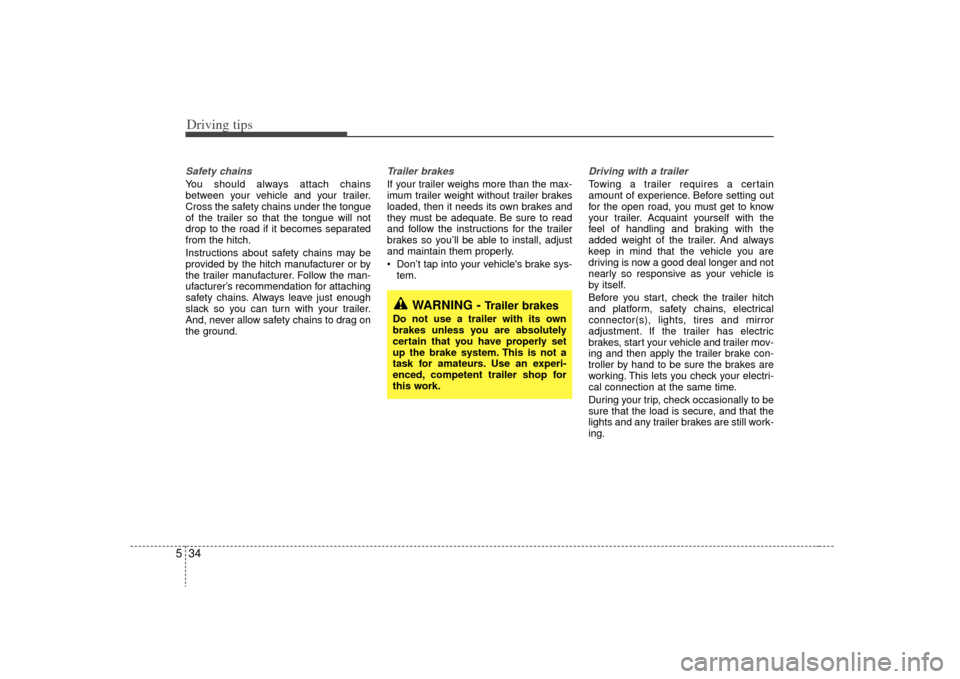
Driving tips34
5Safety chains You should always attach chains
between your vehicle and your trailer.
Cross the safety chains under the tongue
of the trailer so that the tongue will not
drop to the road if it becomes separated
from the hitch.
Instructions about safety chains may be
provided by the hitch manufacturer or by
the trailer manufacturer. Follow the man-
ufacturer’s recommendation for attaching
safety chains. Always leave just enough
slack so you can turn with your trailer.
And, never allow safety chains to drag on
the ground.
Trailer brakes If your trailer weighs more than the max-
imum trailer weight without trailer brakes
loaded, then it needs its own brakes and
they must be adequate. Be sure to read
and follow the instructions for the trailer
brakes so you’ll be able to install, adjust
and maintain them properly.
Don’t tap into your vehicle's brake sys-
tem.
Driving with a trailer Towing a trailer requires a certain
amount of experience. Before setting out
for the open road, you must get to know
your trailer. Acquaint yourself with the
feel of handling and braking with the
added weight of the trailer. And always
keep in mind that the vehicle you are
driving is now a good deal longer and not
nearly so responsive as your vehicle is
by itself.
Before you start, check the trailer hitch
and platform, safety chains, electrical
connector(s), lights, tires and mirror
adjustment. If the trailer has electric
brakes, start your vehicle and trailer mov-
ing and then apply the trailer brake con-
troller by hand to be sure the brakes are
working. This lets you check your electri-
cal connection at the same time.
During your trip, check occasionally to be
sure that the load is secure, and that the
lights and any trailer brakes are still work-
ing.
WARNING -
Trailer brakes
Do not use a trailer with its own
brakes unless you are absolutely
certain that you have properly set
up the brake system. This is not a
task for amateurs. Use an experi-
enced, competent trailer shop for
this work.
Page 268 of 327
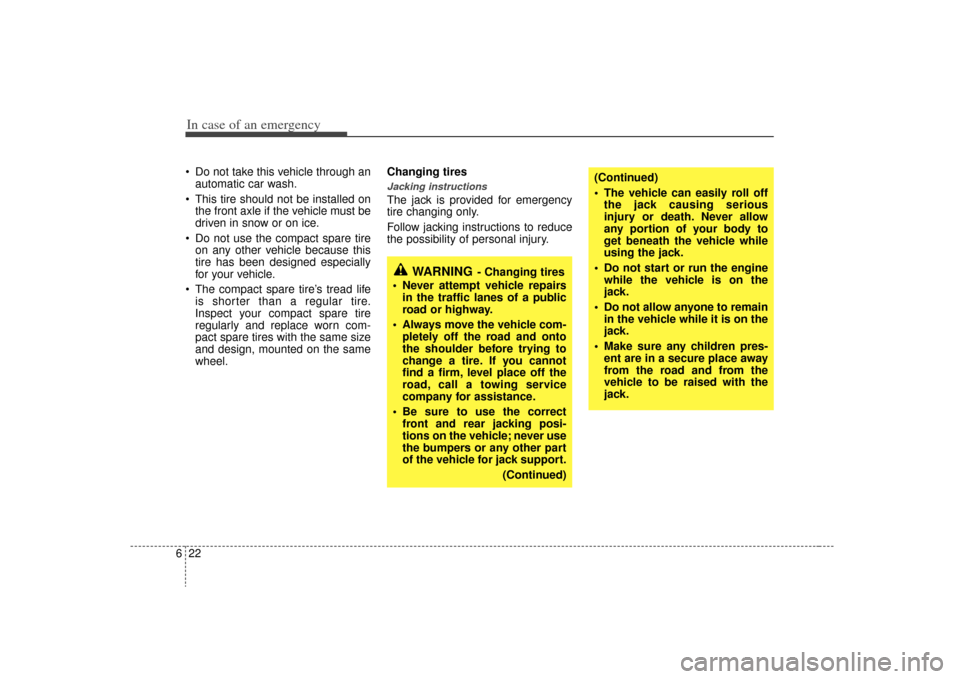
In case of an emergency22
6 Do not take this vehicle through an
automatic car wash.
This tire should not be installed on the front axle if the vehicle must be
driven in snow or on ice.
Do not use the compact spare tire on any other vehicle because this
tire has been designed especially
for your vehicle.
The compact spare tire’s tread life is shorter than a regular tire.
Inspect your compact spare tire
regularly and replace worn com-
pact spare tires with the same size
and design, mounted on the same
wheel. Changing tires
Jacking instructions The jack is provided for emergency
tire changing only.
Follow jacking instructions to reduce
the possibility of personal injury.
WARNING
- Changing tires
Never attempt vehicle repairs in the traffic lanes of a public
road or highway.
Always move the vehicle com- pletely off the road and onto
the shoulder before trying to
change a tire. If you cannot
find a firm, level place off the
road, call a towing service
company for assistance.
Be sure to use the correct front and rear jacking posi-
tions on the vehicle; never use
the bumpers or any other part
of the vehicle for jack support.
(Continued)
(Continued)
The vehicle can easily roll offthe jack causing serious
injury or death. Never allow
any portion of your body to
get beneath the vehicle while
using the jack.
Do not start or run the engine while the vehicle is on the
jack.
Do not allow anyone to remain in the vehicle while it is on the
jack.
Make sure any children pres- ent are in a secure place away
from the road and from the
vehicle to be raised with the
jack.